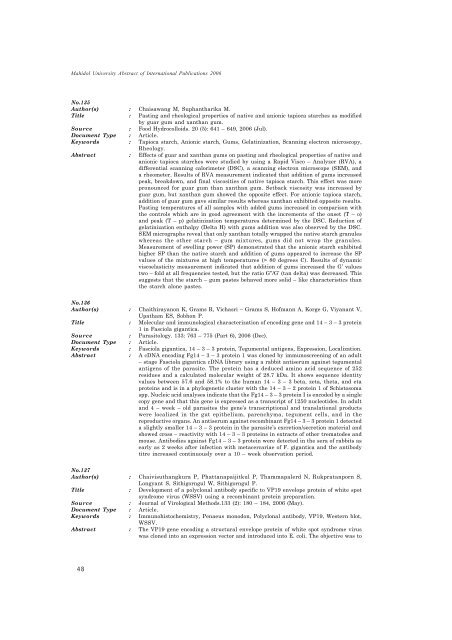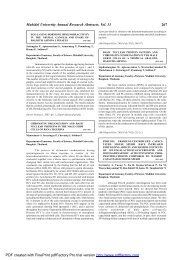2006 ที่น้องแอนทำ.pmd - Mahidol University
2006 ที่น้องแอนทำ.pmd - Mahidol University
2006 ที่น้องแอนทำ.pmd - Mahidol University
You also want an ePaper? Increase the reach of your titles
YUMPU automatically turns print PDFs into web optimized ePapers that Google loves.
<strong>Mahidol</strong> <strong>University</strong> Abstract of International Publications <strong>2006</strong><br />
No.135<br />
Author(s) : Chaisawang M, Suphantharika M.<br />
Title : Pasting and rheological properties of native and anionic tapioca starches as modified<br />
by guar gum and xanthan gum.<br />
Source : Food Hydrocolloids. 20 (5): 641 – 649, <strong>2006</strong> (Jul).<br />
Document Type : Article.<br />
Keywords : Tapioca starch, Anionic starch, Gums, Gelatinization, Scanning electron microscopy,<br />
Rheology.<br />
Abstract : Effects of guar and xanthan gums on pasting and rheological properties of native and<br />
anionic tapioca starches were studied by using a Rapid Visco – Analyzer (RVA), a<br />
differential scanning calorimeter (DSC), a scanning electron microscope (SEM), and<br />
a rheometer. Results of RVA measurement indicated that addition of gums increased<br />
peak, breakdown, and final viscosities of native tapioca starch. This effect was more<br />
pronounced for guar gum than xanthan gum. Setback viscosity was increased by<br />
guar gum, but xanthan gum showed the opposite effect. For anionic tapioca starch,<br />
addition of guar gum gave similar results whereas xanthan exhibited opposite results.<br />
Pasting temperatures of all samples with added gums increased in comparison with<br />
the controls which are in good agreement with the increments of the onset (T – o)<br />
and peak (T – p) gelatinization temperatures determined by the DSC. Reduction of<br />
gelatinization enthalpy (Delta H) with gums addition was also observed by the DSC.<br />
SEM micrographs reveal that only xanthan totally wrapped the native starch granules<br />
whereas the other starch – gum mixtures, gums did not wrap the granules.<br />
Measurement of swelling power (SP) demonstrated that the anionic starch exhibited<br />
higher SP than the native starch and addition of gums appeared to increase the SP<br />
values of the mixtures at high temperatures (> 80 degrees C). Results of dynamic<br />
viscoelasticity measurement indicated that addition of gums increased the G’ values<br />
two – fold at all frequencies tested, but the ratio G’’/G’ (tan delta) was decreased. This<br />
suggests that the starch – gum pastes behaved more solid – like characteristics than<br />
the starch alone pastes.<br />
No.136<br />
Author(s) : Chaithirayanon K, Grams R, Vichasri – Grams S, Hofmann A, Korge G, Viyanant V,<br />
Upatham ES, Sobhon P.<br />
Title : Molecular and immunological characterization of encoding gene and 14 – 3 – 3 protein<br />
1 in Fasciola gigantica.<br />
Source : Parasitology. 133: 763 – 775 (Part 6), <strong>2006</strong> (Dec).<br />
Document Type : Article.<br />
Keywords : Fasciola gigantica, 14 – 3 – 3 protein, Tegumental antigens, Expression, Localization.<br />
Abstract : A cDNA encoding Fg14 – 3 – 3 protein 1 was cloned by immunoscreening of an adult<br />
– stage Fasciola gigantica cDNA library using a rabbit antiserum against tegumental<br />
antigens of the parasite. The protein has a deduced amino acid sequence of 252<br />
residues and a calculated molecular weight of 28.7 kDa. It shows sequence identity<br />
values between 57.6 and 58.1% to the human 14 – 3 – 3 beta, zeta, theta, and eta<br />
proteins and is in a phylogenetic cluster with the 14 – 3 – 2 protein 1 of Schistosoma<br />
spp. Nucleic acid analyses indicate that the Fg14 – 3 – 3 protein I is encoded by a single<br />
copy gene and that this gene is expressed as a transcript of 1250 nucleotides. In adult<br />
and 4 – week – old parasites the gene’s transcriptional and translational products<br />
were localized in the gut epithelium, parenchyma, tegument cells, and in the<br />
reproductive organs. An antiserum against recombinant Fg14 – 3 – 3 protein 1 detected<br />
a slightly smaller 14 – 3 – 3 protein in the parasite’s excretion/secretion material and<br />
showed cross – reactivity with 14 – 3 – 3 proteins in extracts of other trematodes and<br />
mouse. Antibodies against Fg14 – 3 – 3 protein were detected in the sera of rabbits as<br />
early as 2 weeks after infection with metacercariae of F. gigantica and the antibody<br />
titre increased continuously over a 10 – week observation period.<br />
No.137<br />
Author(s) : Chaivisuthangkura P, Phattanapaijitkul P, Thammapalerd N, Rukpratanporn S,<br />
Longyant S, Sithigorngul W, Sithigorngul P.<br />
Title : Development of a polyclonal antibody specific to VP19 envelope protein of white spot<br />
syndrome virus (WSSV) using a recombinant protein preparation.<br />
Source : Journal of Virological Methods.133 (2): 180 – 184, <strong>2006</strong> (May).<br />
Document Type : Article.<br />
Keywords : Immunohistochemistry, Penaeus monodon, Polyclonal antibody, VP19, Western blot,<br />
WSSV.<br />
Abstract : The VP19 gene encoding a structural envelope protein of white spot syndrome virus<br />
was cloned into an expression vector and introduced into E. coli. The objective was to<br />
48
















